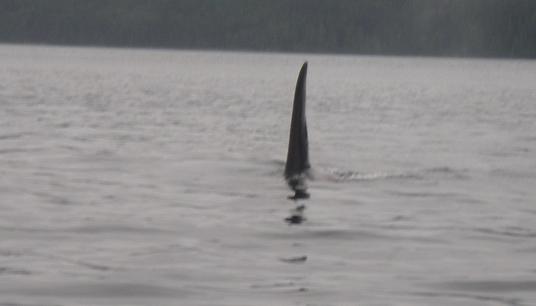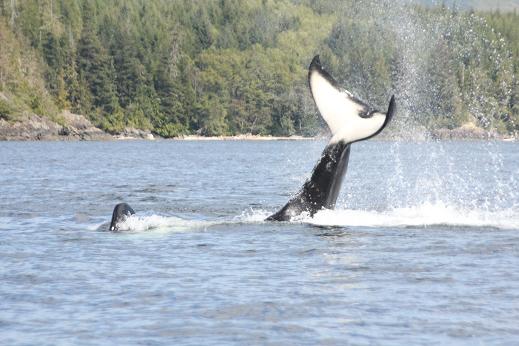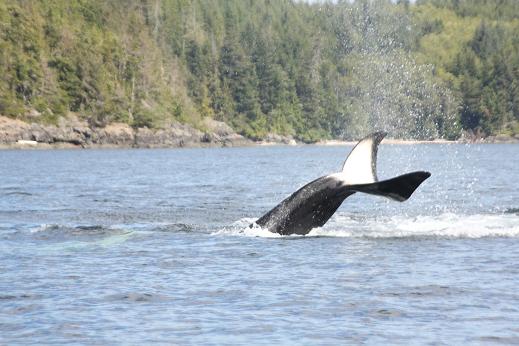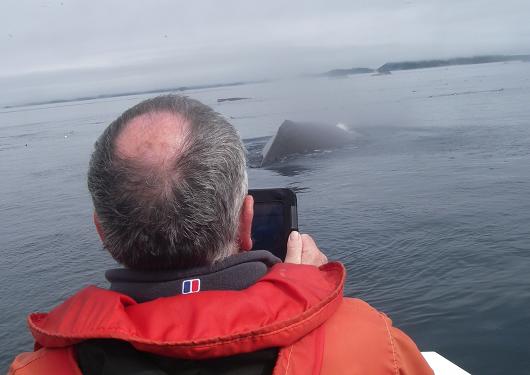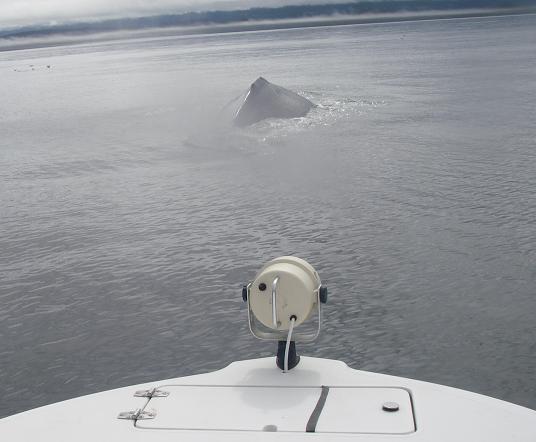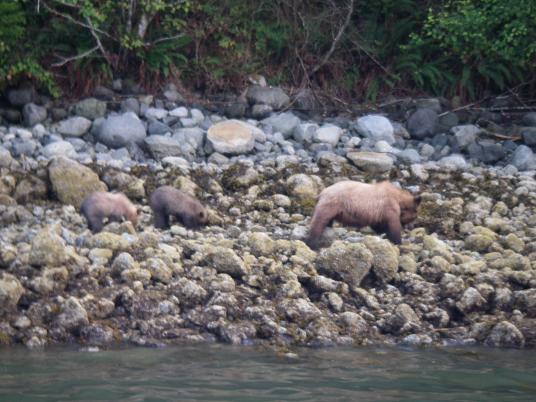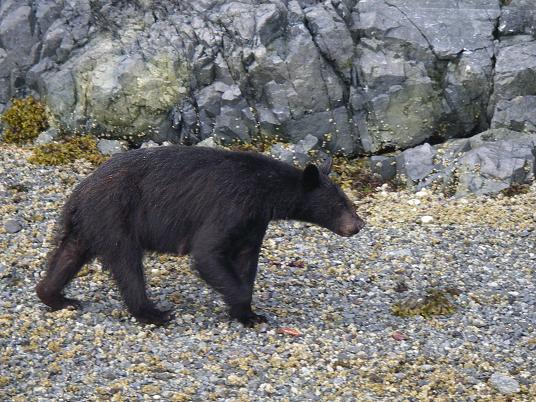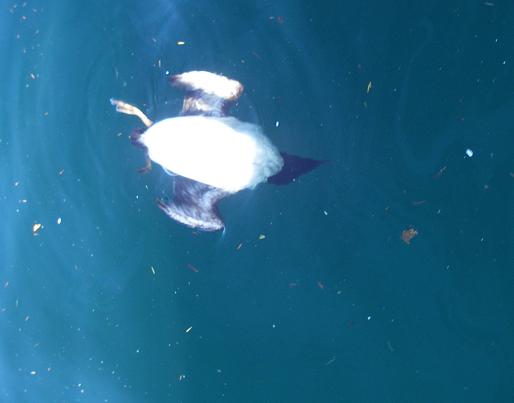Yes it is normal to have killer whales / orca travel in pods that are a complex matriarchal society. Sons and daughters stay with their mother throughout their lives, even after they have offspring of their own. However this does not mean that the larger and older males are always in close proximity they often travel separate but parallel to the family group. For photos it is good to find a large male as they are slower to come out of the water and when the tip of their large dorsal fin shows you have time for a photo. This photo leads to tomorrow’s post….
Whale Watching
We’re not all about the bears, whales are abundant here too!
Killer whales and humpback whales are often seen during our wildlife tours. There are resident whales and transient whales that can be seen feeding and playing in our waters.
Pacific White-sided Dolphins Playing
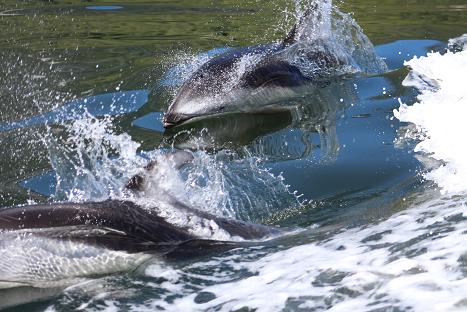 Peder and Ann again capture the activity on one of their days from their visit in July, 2015. For me as a guide and I know from the guest comments this is one of the highlights of a day on the water – a group of Pacific White-sided Dolphins. Such a clear and sharp photo emphasizes the speed of these dolphins as they keep pace with our boat. The Marine Mammal Watching Guidelines say we are to stay one hundred meters from the dolphins but unfortunately or fortunately depending on your point of view the dolphins cannot read.
Peder and Ann again capture the activity on one of their days from their visit in July, 2015. For me as a guide and I know from the guest comments this is one of the highlights of a day on the water – a group of Pacific White-sided Dolphins. Such a clear and sharp photo emphasizes the speed of these dolphins as they keep pace with our boat. The Marine Mammal Watching Guidelines say we are to stay one hundred meters from the dolphins but unfortunately or fortunately depending on your point of view the dolphins cannot read.
Active Humpback Whale Taillobbing
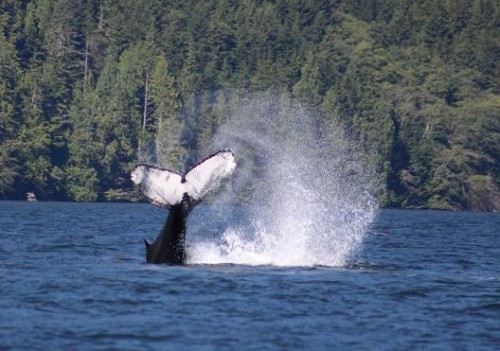 Peder and Ann, just so you know, Angus has informed me that the humpback that is tail slapping is called “Lucky”. If it was my photo with my point and shoot Pentax I would say that it was a lucky photo but from the number of great photos that you have sent us I know that there was a lot of skill involved. This type of behaviour from the humpback whales while we are on a whale watching tour has become much more common over the past few years but capturing such a good photo is still rare. Thank you.
Peder and Ann, just so you know, Angus has informed me that the humpback that is tail slapping is called “Lucky”. If it was my photo with my point and shoot Pentax I would say that it was a lucky photo but from the number of great photos that you have sent us I know that there was a lot of skill involved. This type of behaviour from the humpback whales while we are on a whale watching tour has become much more common over the past few years but capturing such a good photo is still rare. Thank you.
Orca pod spy hopping?
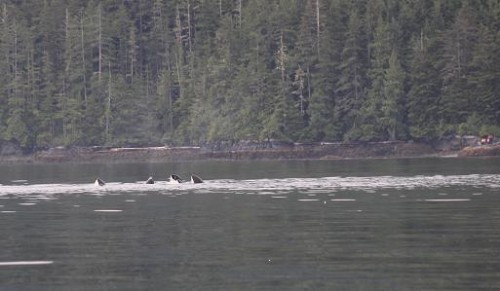 Ian and Julie’s photo is another first in that is has multiple spy hops from a pod of killer whales. I remember the day but cannot recall the reason for this spy hopping. It obviously occurs when the orca want to see the above water activity which may be a fast moving boat, commercial fishing in the area and even saw spy hopping when one the “Whale Research Vessels” was flying a drone to get some pictures. Also note on shore in the right hand corner the campers on the beach watching the orca pass. There are numerous kayak camps along the shore which are very busy in the summer.
Ian and Julie’s photo is another first in that is has multiple spy hops from a pod of killer whales. I remember the day but cannot recall the reason for this spy hopping. It obviously occurs when the orca want to see the above water activity which may be a fast moving boat, commercial fishing in the area and even saw spy hopping when one the “Whale Research Vessels” was flying a drone to get some pictures. Also note on shore in the right hand corner the campers on the beach watching the orca pass. There are numerous kayak camps along the shore which are very busy in the summer.
Killer Whale tail slapping
A killer whale’s inverted Tail Lob – while on its back, it raises its flukes above the water’s surface and brings them down with force. This type of behavior is often viewed when the whales are in close contact with their pod or grouped together with other pods and seems to be a form of communication. Whether tail slapping is a friendly or an aggressive form of behaviour is not proved beyond a doubt but a majority of the times it seems to be a playful thing especially within the Northern Resident Whales that are in our viewing area. The sound that echoes after a tail slap can be very loud.
Humpback whale off bow of boat 2 of 2
They were not paying attention because there were two humpback whales of the stern. And one was closer than the one from the front but I missed the tail again. I did get the photo I wanted one that shows a guest getting a close up of the whale activity we frequently experience on your marine wildlife trips. It in not uncommon to see a dozen or more humpbacks on a day trip from Grizzly Bear Lodge and when we stop for lunch and drift in an area where the whales are feeding it can get very interesting.
Humpback whale off bow of boat 1 of 2
Evening black bear tour from Grizzly Bear Lodge
Yesterday’s post was a black bear on a whale watching tour while today’s is a grizzly bear on an evening black bear tour. On your first evening in the lodge we go for an hour or so boat ride looking for black bears and other wildlife. I remember this trip as it was the longest evening black bear tour that lasted two and half hours (we did get back before dark but just). We found a mother grizzly and two cubs on the beach and we followed them for over an hour as they slowly made their way along the beach turning over rocks and at time stopping to berries and eat grass above the high tide mark. Our tours do not normally have a tight schedule if we find something interesting we watch.
Black bear on the beach without cub
This black bear mother was spotted on the way to our day’s whale watching tour. It is a good area to find black bears especially if there is a low tide in the morning. This nursing mother (look closely at the photo) was on the beach alone that means she must have left her cub sleeping in the bush the above high water mark. We know she has one cub because we had seen them in this area on the previous day.
Common Murre and Killer Whale Saga
The common murre is a medium-sized waterbird with a black back and head, white underside and a long, slender, pointed bill. Ironically except for the waterbird and bill it also describes an orca / killer whale. On this morning we came upon a lone transient or Biggs orca (they are the mammal eaters). It was odd enough for this orca to be on its own but apparently it travels this way frequently. It was also playing with the murres with unfortunate side effects. It would come up beneath the birds and grab them and then toss them into the air. It would play with them for a while and then find another. It was fascinating to watch but also sad as there were four murres left on the surface.
